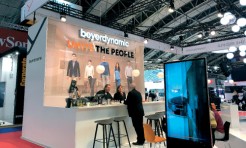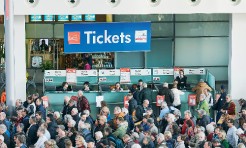Austria: Climate protection – the practical way
Saving energy plays a major role at events in the Alpine
Republic. This has an impact both on topics and practical measures.
Just a few more days to go: From
27 February to 3 March expoEnergy - Energiesparmesse Wels will be opening its
gates. Austria’s
meeting point for energy-efficient heating, construction and renovation aims to
be just as successful as last year’s event. In 2012 over 900 exhibitors from 13
nations showed their products and novelties on just under 70,000 square metres.
Their offerings met with strong demand. “Energiesparmesse is one of the
most-visited trade fairs in Europe for green
energy and energy efficiency,” points out Robert Schneider. “With the greatest
volume of visitors of all Austrian construction and HVAC trade fairs,” the Managing
Director of Messe Wels refers to over 100,000 people who are expected to come
to the five-day event again.
In view of the positive
response the fair will retain its combination of two days for professional
visitors and three days for the public. Energiesparmesse will kick off on 27
February with Austria’s
leading HVAC industry event in an exclusively reserved area of the fair. One
day later the entire trade fair premises will be open to all professional
visitors. And private builders and renovators will be able to explore the
novelties from 1 March. Austria’s
largest solar energy exhibition will also be taking place at Energiesparmesse. Around
90 exhibitors will be presenting the latest trends on a total of 8,000 square
metres. “Solar energy is the easiest and most logical way to heat water and a
practical way to protect the climate,” says Robert Schneider. “With solar
energy you can save two-thirds of the energy costs for hot water and one-third
for heating.” The photovoltaic exhibition area also continues to grow and a
special LED show informs about how to save energy with modern lighting. Energy
efficiency plays a major role for “Energy Capital Wels”. Since 2008 the
exhibition centre has boasted Austria’s
largest building-integrated solar thermal plant on the roof of hall 20 (www.messe-wels.at).
For Messezentrum Salzburg protecting the environment
and climate is a fundamental topic. This includes separating wastes at trade
fairs and energy-saving measures on the entire site . “Our selection criteria for
the suppliers we work with include not only quality but also their proximity,” says
Henrik Häcker. “With this we want to reduce our carbon footprint,” says the
Managing Director of Messezentrum Salzburg. For example, regional produce is
favoured for visitor catering, so as to avoid long supply routes. The venue
itself runs solely on green energy generated by small hydropower plants in Salzburg. In addition,
natural light in the exhibition halls creates a pleasant atmosphere and reduces
energy consumption. Fluorescent lamps have been fitted in all spotlights and light
strips. “We have installed movement sensors in the corridors and toilets, so
that lights are not left on unnecessarily,” Henrik Häcker cites a further
example. “And our ventilation and air conditioning systems use heat recovery.”
To
reduce water consumption the Salzburgers have installed water-saving taps in all
sanitary facilities. Green products are used for cleaning so as not to pollute
groundwater. Neither is fuel-guzzling transport required to the venue. “Messezentrum
Salzburg and Salzburgarena are easy to reach by public transport,” says Henrik
Häcker. “Visitors to our own events even travel for free.” Where required, a
bus shuttle is available, which travels to and from the nearby stadium. E-bikes
are provided to exhibition centre staff. They can use them to travel even long
distances in a fast and energy-efficient manner. Currently, Messezentrum
Salzburg is aiming for international certification according to ISO 20121 standard,
the world’s first standard for sustainable event management. ISO 20121 defines
sustainability not only as protecting the environment but also integrates the social
and economic aspects of an event (www.messezentrum-salzburg.at).
Design Center Linz has been “going green” for some time now. Its ecological concept already started during the planning stage of the venue. Investments were already made in sustainable technology when building the glass and steel construction. The specially developed glass roof prevents overheating despite providing natural light for the interior. In early January the centre received a Green Meetings and Events certificate from Austrian environment minister Niki Berlakovich for its ecological commitment. At Ferien-Messe Wien Managing Director Thomas Ziegler and Sales & Marketing Director Heidrun de Jong were awarded the green certificate. This has made the Design Center the first venue to receive Green Meetings und Events certification for a term of four years in Upper Austria.
Now organisers can use the Design Center
to plan ecologically and economically sustainable meetings and events. The
greatest advantage of green events is the huge image boost, which is becoming
increasingly noticeable in the MICE industry. Key elements of green meetings include
environment-friendly travel options, waste reduction, waste separation and energy
efficiency, as Linz
confirms. Creating value for the region and catering with local and organic
fair trade produce also plays a major role. “Perhaps one day conventions will
only take place in green, socially and environmentally responsible venues,” forecasts
Thomas Ziegler. If this really happens, the Design Center
will be one of the pioneers of the business (www.design-center.at).
International show Interalpin in Innsbruck
From 10 to 12 April 2013 Interalpin will lure thousands of visitors and exhibitors from all over the world to Innsbruck. Staged every two years at Messe Innsbruck, the event is the world’s leading trade show for Alpine technologies and the cable car industry. And it is the number one industry meeting point not least because novel products are presented here for the first time. The last Interalpin two years ago posted 600 exhibiting companies from 39 countries on 35,000 square metres. Just under 20,000 decision-makers from 70 nations attended the event. Interalpin visitors generate returns of approx €10m. In addition, they serve to promote and disseminate regional tourism. With 40 million overnights a year, the Tyrol is already a popular travel destination. Over the last few years the federal state capital of Innsbruck has also established itself in the international meetings and exhibition sector. Together, the three venues are operated by Congress und Messe Innsbruck (CMI). At the beginning of 2013 Christian Mayerhofer, formerly with Reed Fairs Germany, took over at the helm, as the successor of long-serving CEO Georg Lamp. Since the inauguration of the converted and expanded Messe Innsbruck a year ago it has offered optimum conditions for events in the new halls and rooms of the 40,000-square metre centre. Apart from its flagship Interalpin and other existing trade fairs CMI wants to integrate all major Alpine topics in its portfolio, as Christian Mayerhofer points out. Currently 600 events are staged in Innsbruck every year attracting 500,000 visitors (www.come-innsbruck.at).
Author: Peter Borstel
This article was published in TFI issue 1/2013
Share in Facebook, Twitter or Google+:
TFI - Trade Fairs International - The International Trade Fair Magazine.
© 2006 - 2024 by TFI-Verlagsgesellschaft mbH. All rights reserved. TFI-Verlagsgesellschaft mbH shall accept no responsibility for the contents of external links and other contents.
TFI-Know-how
-
What to do when things go wrong at virtual or in-person events?

In the event world, it’s simply part of life if things don’t work out as planned.
-
How can networking be made to work at online events?

Networking typically happens at real, in-person events. But it’s also possible to do it online; it just works a little differently. There are various options available to organisers.
-
How can exhibitors stand out at trade fairs?

New products and a well-conceived stand design are not the only drivers for a successful presence. Many other factors are also important, but trade fair planners often lose sight of them.
-
How can industry decision-makers be reached online?

Trade fairs and trade fair companies need to constantly further develop, become more agile and flexible and offer services all year round. New, digital offerings are very important here. With its TrustedTargeting technology, Messe München offers its customers access to leading business-to-business decision-makers on the Internet.







